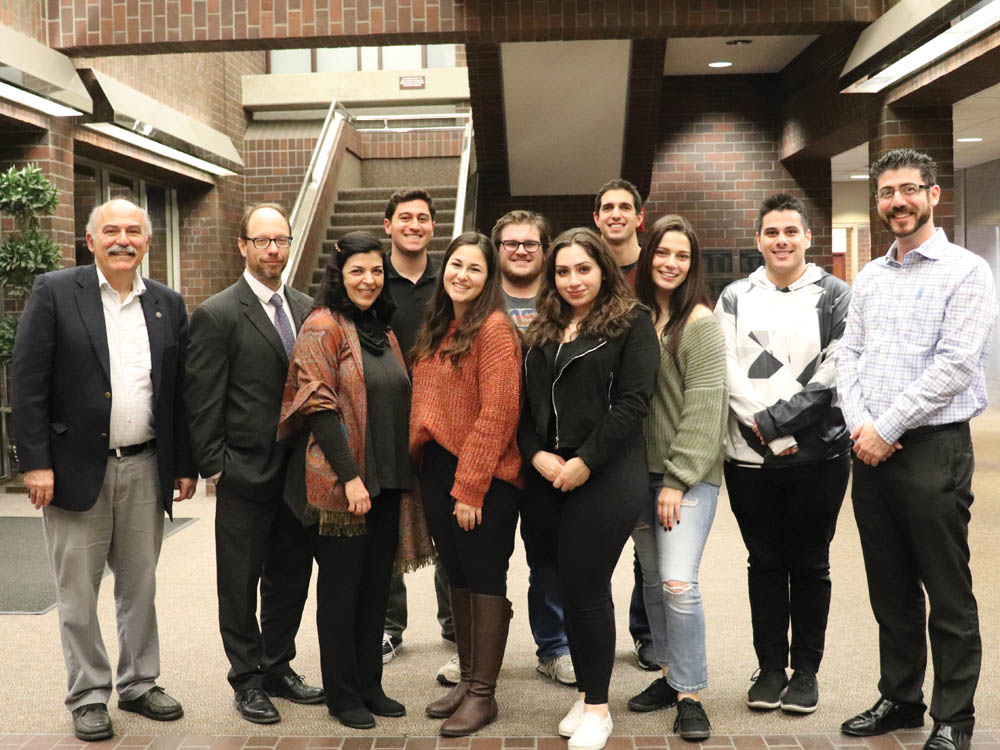
Photo: Andrew Hagopian
Claire Kasaian
Staff Writer
On Tuesday, January 28, author Sato Moughalian gave a presentation titled, “David Ohannessian and the Armenian Ceramics of Jerusalem.” Moughalian, who lives in New York City and wrote the book Feast of Ashes: The Life and Art of David Ohannessian, is the principal flutist for the American Modern Ensemble and the Gotham Chamber Opera. David Ohannessian, who was Moughalian’s grandfather, specialized in the production of Kütahya style ceramics. Ohannessian’s ceramics became famous worldwide and can still be seen on buildings today in Jerusalem. Records about the Armenian Kütahya style ceramics can be found as early as the middle 15th century.
Ohannessian was born in 1884 in Mouradchai, and he learned through the oral stories his family members told that he was a descendant of men who traveled to Kütahya to learn and make Kütahya style ceramics. At age 17 he moved to Kütahya to apprentice in ceramic making.
In the 18th century, Kütahya ceramists started taking on the overflow orders from Iznik. They would make different ceramics items such as coffee pots and cups, plates, bowls, and more. In the 18th century, Kütahya Christian ceramics became popular too, for example, there would be plates created with different Christian decorations.
In the late 19th century, Ottoman leaders commissioned Armenian Kütahya ceramicists to repair mosques damaged by earthquakes, burning summers, and blizzards.
According to Moughalian, at the turn of the century, Ohannessian became famous making such repairs. In 1913-1914, Ohannessian was one of the Armenian ceramicists commissioned to decorate the tomb of the Sultan who later died in 1918. Ohannessian became so popular during this time that Sir Mark Sykes commissioned him to decorate the living room in Sykes’ England mansion, Sledmore House, with his hand-made tiles.
During the Armenian Genocide, Ohannessian and his family were deported, and he almost died of typhus. However he and most of his family miraculously survived, reaching Aleppo in 1916. In 1918, Jerusalem was in search of tile makers to repair holy sites around the city. However, there was no local tile-making industry in Jerusalem. Sykes visited Jerusalem in 1918 and mentioned Ohannessian, who was currently living in Aleppo as a refugee. Ohannessian was brought immediately to Jerusalem and arrived at the end of 1918. In 1919 Ohanessian when back to Kütahya to get supplies and brought other ceramicists and artists back to Jerusalem with him.
When Ohannessian and his fellow artists returned to Jerusalem, they opened a tile workshop called, “Dome of the Rock Tiles Studio.” Orphaned children were taught how to paint tiles and the tiles were used to fix Holy Sites as well as to be sold. Ohannessian also made tiles used for street signs in the Old City of Jerusalem.
Ohannessian became world famous once again, when in 1933, he traveled to Chicago to exhibit his work at the Chicago World’s Fair. He maintained the traditional techniques of making the tiles, including using a wood burning kiln and hand painting the tiles made from natural ingredients. Ohannessian’s tiles still decorate buildings today in Jerusalem. Armenian ceramicists such as the Balians and the Karakashians are still active in Jerusalem today.
Moughalian’s presentation provided a vivid glimpse into her grandfather’s extraordinary life and to the contributions he made to the Kütahya Armenian style of ceramics.
 Hye Sharzhoom Armenian Action
Hye Sharzhoom Armenian Action